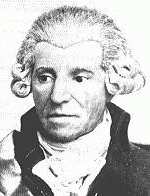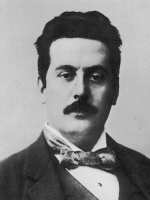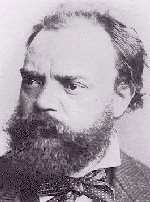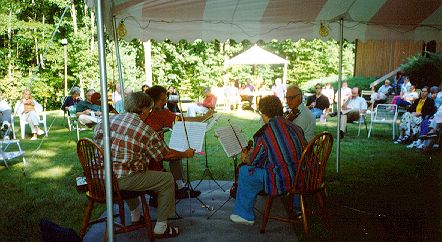Willow
Pond Quartet Concert Program 1996 |
|
Saturday 10 August 1996 at 3:00 p.m. Haydn:
String Quartet in D, Op 20 Nr. 4 Puccini:
Crisantemi (Chrysanthemums) Dvorák:
String Quartet Nr. 12 in F Op 96 "American"
Angelo Frascarelli
(Violin) |
|
|
Haydn:
String Quartet in D, Op 20 Nr. 4 Of
humble origins, Franz Joseph Haydn was born in the village of Rohrau,
near Vienna, on March 31, 1732. When eight years old he was accepted The turning point in Haydn's fortunes came in 1761, when he was appointed assistant music director to Prince Pál Antal Esterházy; a year later he became full director. As Kapellmeister, Haydn served under the patronage of three successive princes of the Esterházy family. The second of these, Pál Antal's brother, Prince Miklós József Esterházy, was an ardent, cultivated music lover. At Esterháza, his vast summer estate, Prince Miklós could boast a musical establishment second to none, the management of which made immense demands on its director. Beyond the symphonies, operas, marionette operettas, masses, chamber pieces, and dance music that Haydn was expected to compose for the prince's entertainment, he was required to rehearse and conduct performances of his own and others' works; coach singers; maintain the instrument collection and music library; perform as organist, violist, and violinist when needed; and settle disputes among the musicians in his charge. Although he frequently regretted the burdens of his job and the isolation of Esterháza, Haydn's position was enviable by 18th-century standards. One remarkable aspect of his contract after 1779 was the freedom to sell his music to publishers and to accept commissions. As a result, much of Haydn's work in the 1780s reached beyond the guests at Esterháza to a far wider audience, and his fame spread accordingly. After the death of Prince Miklós in 1790 his son, Prince Antal, greatly reduced the Esterházy musical establishment. Although Haydn retained his title of Kapellmeister, he was at last free to travel beyond the environs of Vienna. The enterprising British violinist and impresario Johann Peter Salomon lost no time in engaging the composer for his concert series in London. Haydn's two trips to England for these concerts, in 1791-92 and 1794-95, were the occasion of the huge success of his last symphonies. Known as the "Salomon" or "London" symphonies, they include several of his most popular works. In his late years in Vienna, Haydn turned to writing masses and composed his great oratorios. From this period also comes his Kaiser Quartet (1797); its Adagio later became the Austrian national anthem. He died in Vienna, on 31 May 1809, a famous and wealthy man. Haydn was prolific in nearly all genres, vocal and instrumental, sacred and secular. Many of his works were unknown beyond the walls of Esterháza, most notably the 125 trios and other assorted pieces featuring the baryton, a hybrid string instrument played by Prince Miklós. Most of Haydn's nineteen operas and marionette operettas were written to accommodate the talents of the Esterháza company plus the tastes of his prince. Haydn freely admitted the superiority of the operas of his young friend Wolfgang Amadeus Mozart. In other categories, however, his works circulated widely, and his influence was profound. Haydn's productivity is matched by his inexhaustible originality. More than one hundred symphonies and almost eighty string quartets that span his career document a growth from the easy elegance suitable for the home music making to the public virtuosity of his late works. His contemporaries admired his innovative manner of turning a simple tune or motive into unexpectedly complex developments. Dramatic surprise, often turned to humorous effect, is characteristic of his style, as is a fondness for folklike melodies. Haydn's three sets of string quartets (opp 7, 17, and 20) were written over three years starting in 1769 and follow a gap in quartet writing of nearly ten years. The Quartet in D that we hear this afternoon is the fourth from the opus 20 set of six quartets, known as the "Sun" quartets and was composed in 1772 in Esterháza.
Puccini: Crisantemi (Chrysanthemums)
Although definitely a fin-de-siecle artist, Puccini was a master musical dramatist and had a particular gift for setting a scene's mood in music, maintaining narrative flow, individual character development, and dramatic motion while providing for the singers some of the most virtuosic and vivid musical vehicles imaginable. Puccini's non-operatic works are small in number - he wrote fewer than thirty compositions in all forms - and one, his Missa de Gloria is well worth discovering. This afternoon's program contains a short composition for strings that Puccini wrote in 1890 in memory of the Savoy duke Amadeo - who became king of Spain. Crisantemi (Chrysanthemums) has a strong passionate quality not unlike many of his theater pieces.
Dvorák: String Quartet Nr. 12 in F Op 96 "American" Antonín
Dvorák was born in a small village on the banks of the river Vltava,
north of Prague in 1841. He left school aged eleven to After graduating in 1859, Dvorák became principal violist in the new Czech Theater orchestra, conducted after 1866 by Smetana. The need to supplement his income by teaching left Dvorák with limited free time, and in 1871 he gave up the orchestra in order to compose. He fell in love with one of his pupils and wrote a song cycle, Cypress Trees, expressing his anguish at her marriage to another man. He soon overcame his despondency, however, and in 1873 he married her sister Anna Cermakova. In 1874 Dvorák entered no fewer than fifteen works - including his Third Symphony - for the Austrian National Prize. He won and received a welcome cash prize and, perhaps more importantly, the admiration and support of Brahms, who was one of the judges. From this point on Dvorák's fame escalated. In 1884 he received a warm welcome to London, the first of nine visits. He was appointed Professor of Composition at the Prague Conservatoire in 1891, but soon after took up the offer of Mrs. Jeanette Thurber to direct the newly founded National Conservatory of Music in New York. He stayed for three years in the United States, spending summer holidays in Spillville, a Czech-speaking community in Iowa. It is from this period that some of his most performed music comes, notably the Ninth Symphony From the New World and the String Quartet in F American. Both these works make use of themes influenced by Native American folk melodies and Negro spirituals. As Dvorák later admitted, something of their melancholy can be attributed to the homesickness he felt during his time in America. Returning to Prague, with some relief, Dvorák resumed his post at the Prague Conservatoire and in 1901 became its director. For the last three years of his life he devoted the greater part of his creative energies to working on symphonic poems and operas. Dvorák's importance lies partly in his nationalist outlook. During the later half of the nineteenth century, Bohemia (later part of the Czech Republic) - long suppressed under German rule - fought for its political and cultural independence. Dvorák, like Smetana and Janacek, consciously looked to Bohemian folklore for artistic inspiration, imitating traditional melodies, as in the Slavonic Dances, or using traditional legends as subject matter. Dvorák exercised a great gift for absorbing folk styles and reproducing them in the context of the Classical tradition. The composition of the String Quartet in F went rapidly and it was completed within fifteen days in June of 1893. The lively finale of the American Quartet - Vivace ma non troppo - contains a short imitation of a chorale and the movement may be some reminiscence of Sunday activities - dancing and churchgoing - in Spillville. |
|
[Back to Willow Pond Concert Page]
|
 into the choir
school of Saint Stephen's Cathedral in Vienna, where he received his
only formal education. Dismissed from the choir at the age of seventeen,
when his voice broke, he spent the next several years as a struggling
freelance musician. He studied on his own the standard textbooks on
counterpoint and took occasional lessons from the noted Italian singing
master and composer Nicola Porpora. In 1755 Haydn was engaged briefly
by Baron Karl Josef von Fürnberg, for whom he apparently composed
his first string quartets. Haydn's marriage in 1760 to Maria Anna
Keller proved to be unhappy.
into the choir
school of Saint Stephen's Cathedral in Vienna, where he received his
only formal education. Dismissed from the choir at the age of seventeen,
when his voice broke, he spent the next several years as a struggling
freelance musician. He studied on his own the standard textbooks on
counterpoint and took occasional lessons from the noted Italian singing
master and composer Nicola Porpora. In 1755 Haydn was engaged briefly
by Baron Karl Josef von Fürnberg, for whom he apparently composed
his first string quartets. Haydn's marriage in 1760 to Maria Anna
Keller proved to be unhappy.  One of the most
celebrated and familiar composers of Italian opera, Giacomo Puccini
came from a line of musicians that went back five generations. In
his childhood, he studied singing and organ-playing with his uncle,
and his mother encouraged him to high musical achievement - although
the child did not exhibit any unusual talents. At twenty-two, Puccini
had advanced enough in his musical facility to be admitted to the
Milan Conservatory. There he studied with the noted composer Amilcare
Ponchielli; after graduation, he entered an opera competition with
a new composition, Le Villi. The piece did not win, but Ponchielli
thought so highly of it and his star pupil that he had it produced
in Milan in the spring of 1884. The production was a hit, attracting
the attention of the eminent publisher Giulio Ricordi, who commissioned
a second opera from the 26-year-old composer. This work, Edgar,
was a flop, but Puccini kept working under the guidance of Ricordi,
and their third effort, Manon Lescaut, was a huge success upon
its premiere in 1893. Puccini was now a household name in Italy, but
it was not until his next opera La Bohčme that he achieved
international fame. Then came failure - ironically, from perhaps his
most famous work, Madama Butterfly. The opera was premiered
in Milan in February 1904 to boos and catcalls. Puccini took back
the score, reworked it for three months, and mounted a second production
under the baton of Arturo Toscanini. This time it was a huge success,
and is today Puccini's most popular opera. After the first World War
he began to sketch out what would be his last opera - Turandot.
He was not to finish it; a lifelong smoker, Puccini suffered from
throat cancer and died in 1924. Turandot was eventually finished
by a talented student of Puccini's, Franco Alfano, and was premiered
in the spring of 1926 by Toscanini at La Scala.
One of the most
celebrated and familiar composers of Italian opera, Giacomo Puccini
came from a line of musicians that went back five generations. In
his childhood, he studied singing and organ-playing with his uncle,
and his mother encouraged him to high musical achievement - although
the child did not exhibit any unusual talents. At twenty-two, Puccini
had advanced enough in his musical facility to be admitted to the
Milan Conservatory. There he studied with the noted composer Amilcare
Ponchielli; after graduation, he entered an opera competition with
a new composition, Le Villi. The piece did not win, but Ponchielli
thought so highly of it and his star pupil that he had it produced
in Milan in the spring of 1884. The production was a hit, attracting
the attention of the eminent publisher Giulio Ricordi, who commissioned
a second opera from the 26-year-old composer. This work, Edgar,
was a flop, but Puccini kept working under the guidance of Ricordi,
and their third effort, Manon Lescaut, was a huge success upon
its premiere in 1893. Puccini was now a household name in Italy, but
it was not until his next opera La Bohčme that he achieved
international fame. Then came failure - ironically, from perhaps his
most famous work, Madama Butterfly. The opera was premiered
in Milan in February 1904 to boos and catcalls. Puccini took back
the score, reworked it for three months, and mounted a second production
under the baton of Arturo Toscanini. This time it was a huge success,
and is today Puccini's most popular opera. After the first World War
he began to sketch out what would be his last opera - Turandot.
He was not to finish it; a lifelong smoker, Puccini suffered from
throat cancer and died in 1924. Turandot was eventually finished
by a talented student of Puccini's, Franco Alfano, and was premiered
in the spring of 1926 by Toscanini at La Scala.  become an apprentice butcher, and the following year was sent to Zlonce
to learn German. Most of his time, however, he spent on music lessons,
learning the organ, viola, piano and basic composition. His interest
in music was such that, despite misgivings, his father eventually
allowed him to enroll at the Prague Organ School in 1857. There received
the strict training of a church musician, but after classes attended
as many orchestral concerts as he could, enjoying especially the music
of contemporary composers such as Wagner and Schumann.
become an apprentice butcher, and the following year was sent to Zlonce
to learn German. Most of his time, however, he spent on music lessons,
learning the organ, viola, piano and basic composition. His interest
in music was such that, despite misgivings, his father eventually
allowed him to enroll at the Prague Organ School in 1857. There received
the strict training of a church musician, but after classes attended
as many orchestral concerts as he could, enjoying especially the music
of contemporary composers such as Wagner and Schumann. 